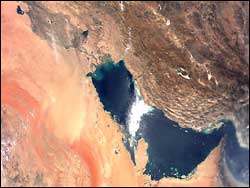A warmer world might not be a wetter one

Regions like the Persian Gulf in the Middle East, shown here by NASA’s Moderate Resolution Imaging Spectroradiometer (MODIS) instrument, may face increasingly severe water shortages as global climate changes. CREDIT: NASA GSFC
A NASA study is offering new insight into how the Earth’s water cycle might be influenced by global change.
In recent years, scientists have warned that the water cycle may be affected by temperature changes, as warmer temperatures can increase the moisture-holding capacity of air.
The global water cycle involves the transfer of water molecules between the Earth’s land masses, cryosphere, oceans and atmosphere. It’s a gigantic system powered by the sun, fueling a continuous exchange of moisture between the oceans, atmosphere and land.
Most climate models have shown that that a warmer climate will increase global evaporation and precipitation, but the atmospheric storage of water vapor has not yet been well studied.
Recently, researchers from NASA Goddard Space Flight Center, Greenbelt, Md., produced climate simulations of the early and late 20th century. They used sea surface temperature (SST) data and two computer models designed at Goddard Space Flight Center to determine how long water stays in the atmosphere. This is one way of measuring how the global water cycle might be influenced by changes in many variables, including temperature and precipitation.
Despite model differences, both simulations showed an increase in global evaporation and precipitation during this period. But, it is important to recognize that simulated atmospheric temperatures also increased during this period, raising the atmosphere’s “total precipitable water” – the amount of liquid water in the atmosphere if all water vapor were suddenly condensed.
“By computing a diagnostic for the water cycle rate, which accounts for total atmospheric water vapor and the average rate of precipitation, the models show the water cycling rate is reduced as the temperature warms,” said Michael Bosilovich, lead author of the study, published in the May 2005 issue of the American Meteorological Society’s Journal of Climate.
When the researchers studied precipitation simulated over land and sea, they found it decreased over land as the local recycling of water vapor was reduced. Oceanic precipitation, however, had an upward trend along with increased sea surface temperatures, consistent with historical data and earlier studies.
“But, it should be noted that these contrasting land and ocean trends are not universally applicable to all regions,” said Bosilovich. “For instance, the precipitation over the North American continent increases, while it decreases over the Gulf of Mexico.”
The study also found that land sources of water for precipitation vary considerably within individual regions. Over time, the continental cycle of water appeared to decline, except in the central United States, where it might increase. But, further study is needed with a regional focus to accurately determine local recycling rates.
“In regard to the global scale, satellite data is an essential tool in assessing the rate and intensity of the global water cycle. It helps to identify the background state of the climate, but is limited by its short duration of record and deficiencies within historical products,” said Bosilovich. “This study highlights the importance of continued high quality, well-maintained observations of atmospheric water content and precipitation rates over both the land and ocean well into the future so that we can more accurately assess changes in the water cycle.”
Today, NASA’s Aqua and Terra satellites are providing such data by giving new, detailed information on processes that contribute to the water cycle. Ultimately these findings, coupled with data from future satellites, will be incorporated into regional and global computer models, improving both short-term weather forecasts and long-term climate forecasts. Such seasonal predictions carry significant economic implications and are also critical to water resource managers in determining water availability and management.
Other research programs like the NASA Energy and Water Cycle Study also use data from NASA satellites to help scientists learn more about the link between climate and the water cycle, improving their ability to predict events like floods and droughts.
Media Contact
More Information:
http://www.nasa.govAll latest news from the category: Power and Electrical Engineering
This topic covers issues related to energy generation, conversion, transportation and consumption and how the industry is addressing the challenge of energy efficiency in general.
innovations-report provides in-depth and informative reports and articles on subjects ranging from wind energy, fuel cell technology, solar energy, geothermal energy, petroleum, gas, nuclear engineering, alternative energy and energy efficiency to fusion, hydrogen and superconductor technologies.
Newest articles

Parallel Paths: Understanding Malaria Resistance in Chimpanzees and Humans
The closest relatives of humans adapt genetically to habitats and infections Survival of the Fittest: Genetic Adaptations Uncovered in Chimpanzees Görlitz, 10.01.2025. Chimpanzees have genetic adaptations that help them survive…

You are What You Eat—Stanford Study Links Fiber to Anti-Cancer Gene Modulation
The Fiber Gap: A Growing Concern in American Diets Fiber is well known to be an important part of a healthy diet, yet less than 10% of Americans eat the minimum recommended…

Trust Your Gut—RNA-Protein Discovery for Better Immunity
HIRI researchers uncover control mechanisms of polysaccharide utilization in Bacteroides thetaiotaomicron. Researchers at the Helmholtz Institute for RNA-based Infection Research (HIRI) and the Julius-Maximilians-Universität (JMU) in Würzburg have identified a…



